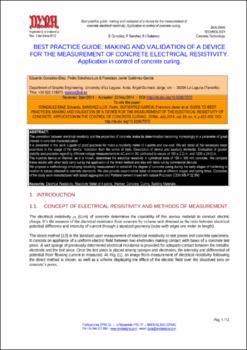BEST PRACTICE GUIDE: MAKING AND VALIDATION OF A DEVICE FOR THE MEASUREMENT OF CONCRETE ELECTRICAL RESISTIVITY. Application in control of concrete curing.
Date
2014Abstract
The correlation between electrical resistivity and the properties of concrete, make its determination becoming increasingly in a parameter of great interest in concrete characterization.
It is presented in this work a guide of good practices for make a resistivity meter of 4-points and low-cost. We will detail all the necessary steps essentials in the usage of the device. Validation from the series of trials. Description of device and auxiliary elements. Evaluation of greater stability and precision regarding different voltage measurements in AC and in DC calibrated to values of 160 ± 2 Ω.m. and 1200 ± 24 Ω.m.
The 4-points device or Wenner, as it is known, determines the electrical resistivity in cylindrical tests of 150 x 300 mm concrete. We compare these results with other tests carry out by the application of the direct method and also with tests run by commercial devices.
We propose a methodology employing resistivity measurement to establish the degree of concrete curing during the early stages of hardening in relation to values obtained in concrete standards. We also provide experimental detail of concrete at different stages and curing times. Concretes
of the study were manufactured with basalt aggregates and Portland cement mixed with natural Pozzolan (CEM II/B-P 32,5N).





